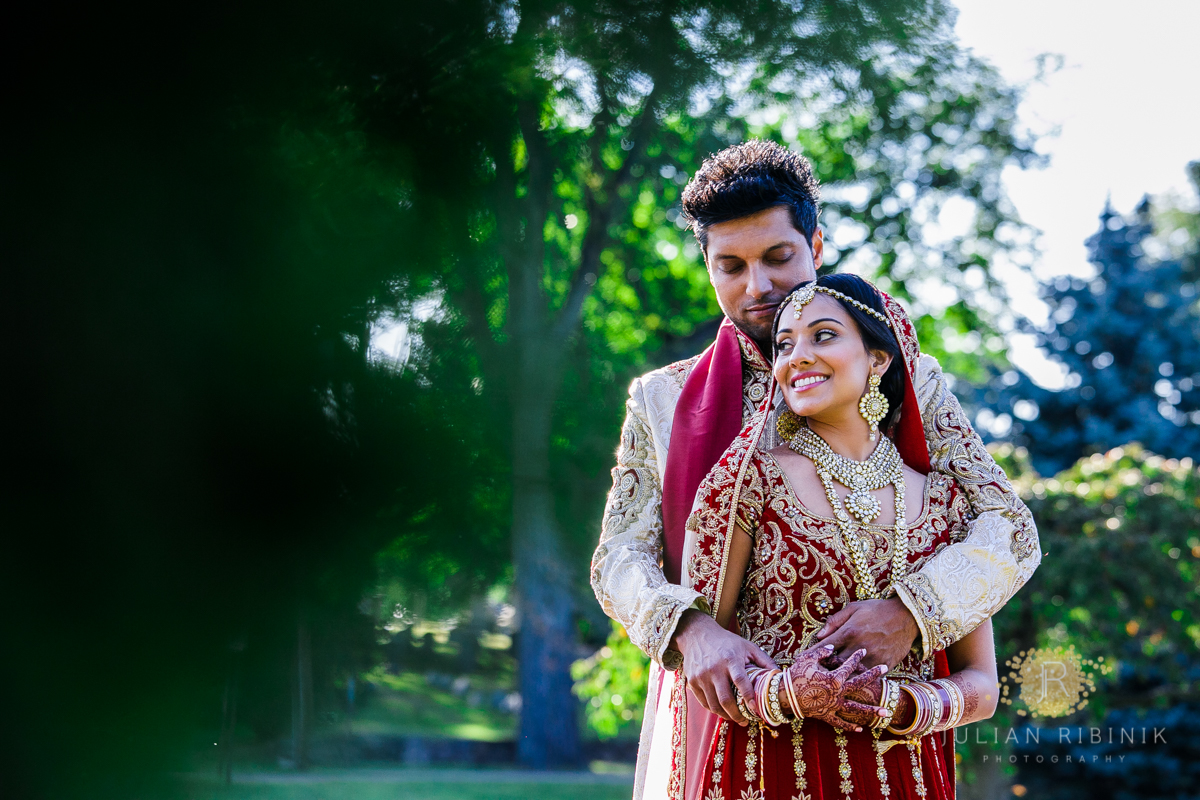Everything You Need to Know About Indian Wedding Traditions
India is one of the world’s most ethnically diverse and vibrant countries. It’s no surprise, then, that Indian wedding ceremonies are incredibly rich in culture and tradition. Indian wedding traditions are known for their opulent displays of color, music, and dance, as well as their elaborate ceremonies and rituals that take place over several days. Capture these fleeting moments with a photographer from NYC!
If you’re an Indian bride-to-be, there are several Indian marriage traditions that you can incorporate into your wedding to make it truly authentic. Just keep in mind that, with over 30 different cultures within the continent of India, your family’s traditions could be very different from other Indian weddings you’ve attended in the past.
From the wedding food and the Indian bridal jewelry to the beautiful clothing and decor, no two Indian weddings are alike. Having photographed some truly extraordinary Indian Weddings in New York City, we’ve put together a list of some of the most popular Indian wedding traditions that you can look forward to.
Table of Contents
- Barni Band-hwana
- The Mayra
- Sangeet & Mehendi
- The Wedding Procession
- The Wedding Ceremony
- Wedding Attire
- The Reception Feast
- Booking a professional photographer ensures that your Indian wedding traditions are captured with outstanding quality and care.
Barni Band-hwana
The wedding rituals usually start fifteen days before the wedding day. For many Indian couples, the Barni Band-hwana ritual is the first step in their wedding journey. During this ritual, a piece of thread known as Mauli is tied around the hands of either the bride and groom or the groom and his parents. The purpose of this ceremony is to ask the gods for a safe wedding day and a long and happy marriage.
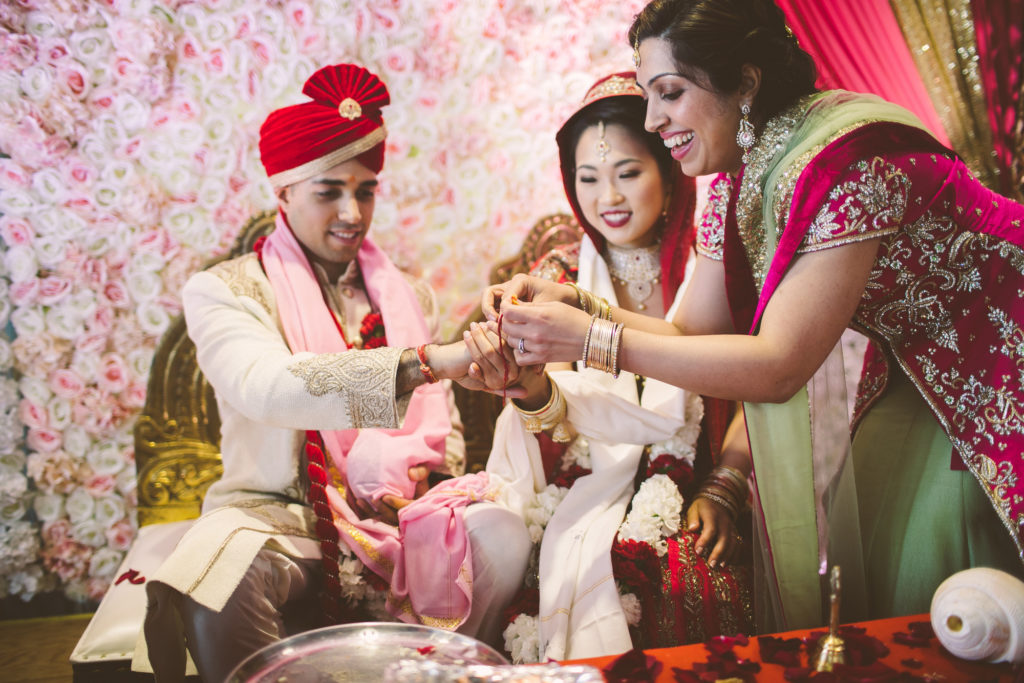
The Mayra
Referred to as the “Maternal Uncle’s Ceremony,” the Mayra is when the maternal uncle brings gifts for the mother of the bride and the groom. Among these gifts are the mothers’ dresses for the wedding.
Sangeet & Mehendi
The Sangeet is a pre-wedding celebration where the bride and groom’s families come together to celebrate with music, dance, and food. The bride’s family hosts the Sangeet, where the bride, her female family members, and guests get henna applied on their hands. This is an opportunity for both sides of the family to get to know each other. Some families take this as an opportunity to lovingly tease the bride and groom.
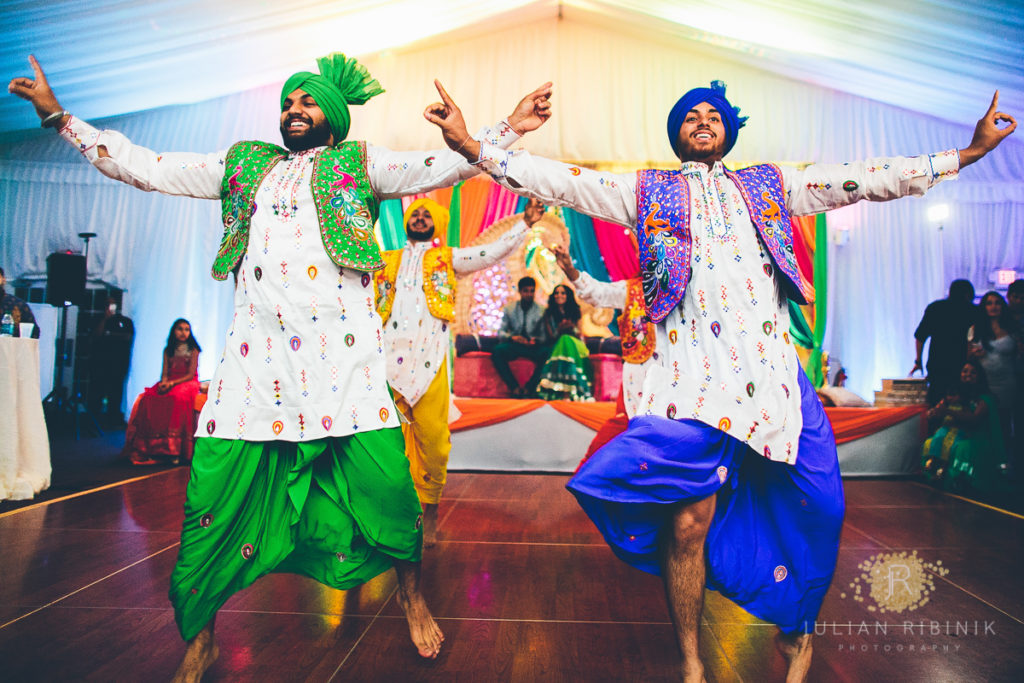
The Mehendi ceremony takes place during the Sangeet. This is when henna is applied to the bride, her female family members, and guests. Depending on how many women attend, the family will hire two or three henna artists to design and apply the henna.
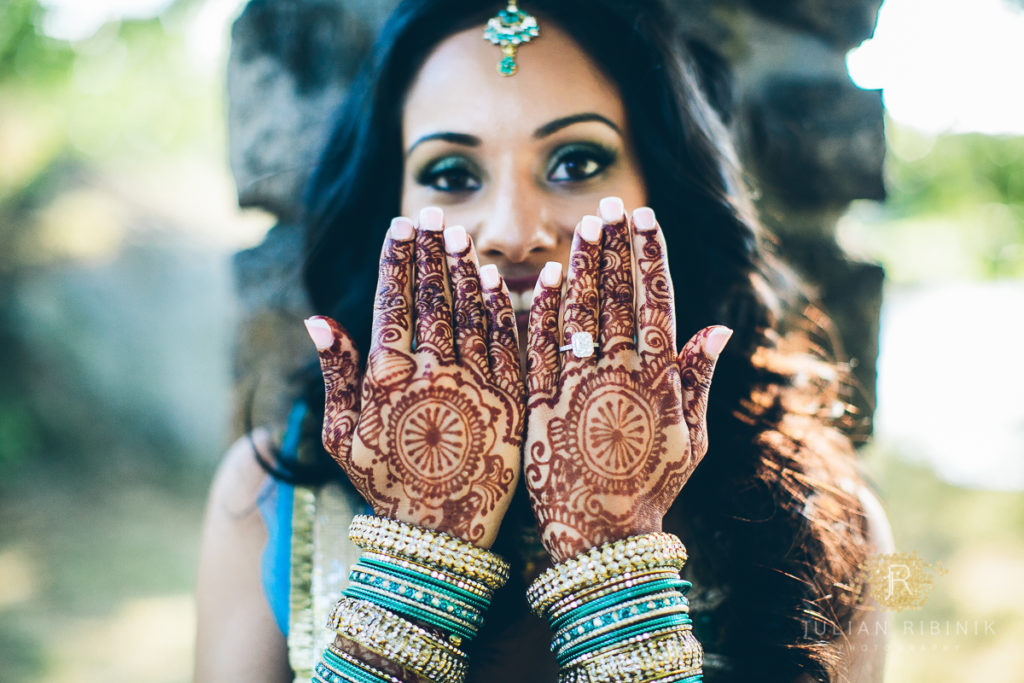
What is Henna?
Henna is a temporary, orange-red dye made from the leaves of the Lawsonia inermis plant. The henna tattoo lasts for about two weeks and is an integral part of Indian wedding traditions.
What do Henna Tattoos Symbolize?
According to Indian wedding traditions, applying henna to the hands, feet, and arms of a woman is said to aid fertility, ward off evil, and attract positive energy. Hidden within the bride’s intricate artwork are the names of both the bride and groom, which the groom is meant to find as a further sign of good luck.
There is also a superstition surrounding henna. It’s said that a deeper color can lead to a deeper bond with your husband and a greater chance of getting along with your mother-in-law. For this reason, many brides choose to let the henna dry and darken.
The Wedding Procession
With most traditional Indian wedding celebrations, the wedding day begins with the groom’s procession. This “ceremony within a ceremony” is called the Baraat, and it’s when the groom makes his way to the wedding altar, led by his entire family and friends.
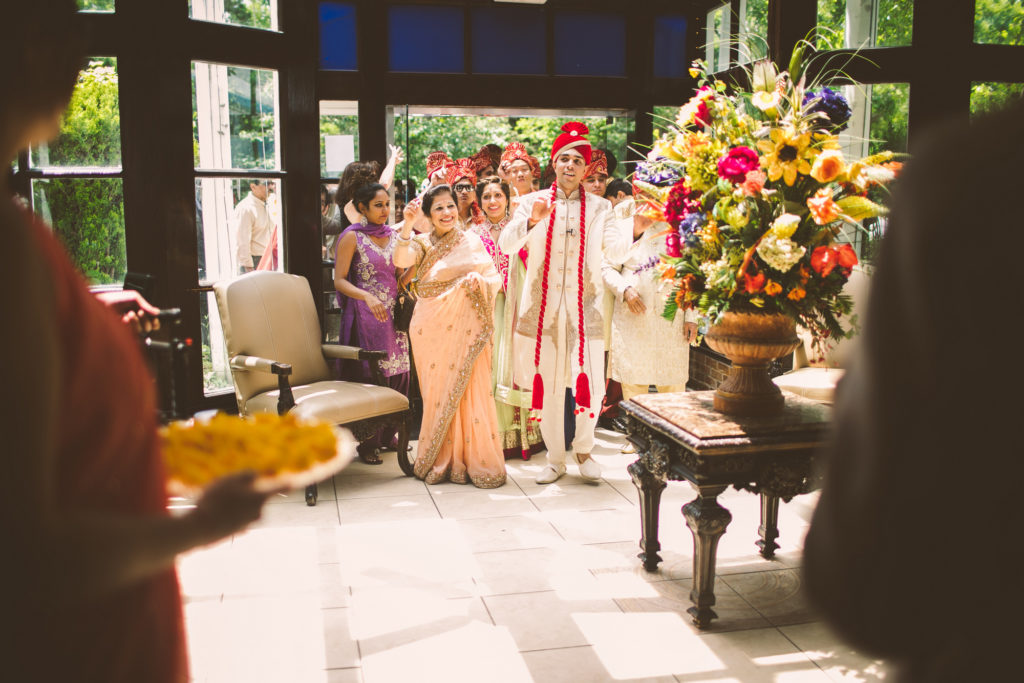
This part of the ceremony serves as the groom’s entrance. During this time, his friends and family dance and chant Indian wedding day wishes. This rousing spectacle takes place as he is ushered down the line either on the shoulders of his friends or on the back of a white horse.
During the Baraat, the groom wears an intricately designed Sherwani suit and an impressive Safa (turban) fitted with an ornate brooch known as a Kalgi. After the groom arrives, he’s greeted by the bride and her family. The couple then exchanges Milni Malas, which are floral garlands.
The bride’s family then welcomes the groom and his procession. His immediate family members take their place at the altar.
The Wedding Ceremony
Hindu wedding ceremonies occur under a spectacular canopy known as a Mandap, which features beautifully colored fabrics. The canopy is decorated with colorful flowers and sits atop 4 massive pillars. Each pillar represents one of the four parents. Whether the wedding is held indoors or outdoors, a Mandap is built as an essential part of the ceremony.
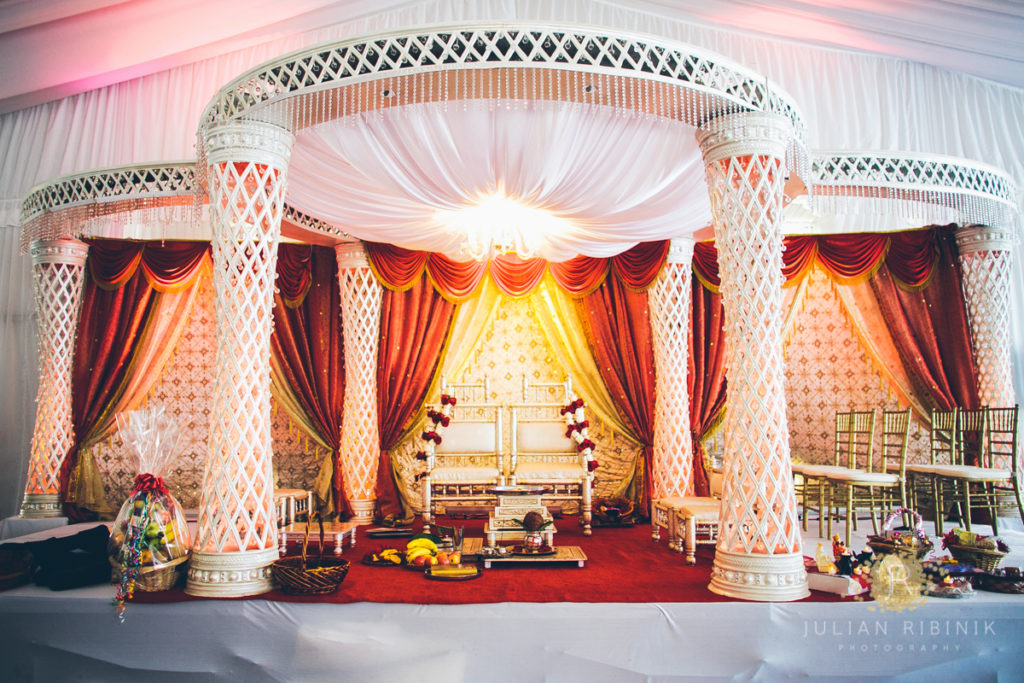
At the front of the Mandap, a fire is lit in a small dish. The fire represents Agni, who is the Hindu god of fire that gives life to the marriage. The fire is kept burning throughout the ceremony and serves as a witness to the exchanged vows between the bride and groom.
The groom, wedding guests, and the officiant then await the bride, who is escorted down the aisle by her maternal uncle. Once she arrives at the altar, the bride and her groom are given rice to throw into Agni’s ceremonial fire.
As part of Indian wedding traditions, the ceremony begins with Kanyadaan, a ritual where the bride’s parents give their daughter away to the groom. The Pandit then ties their ceremonial scarves together, and the bride and groom join hands to prepare for the Mangal Phera ritual.
Hand in hand, the bride and groom walk around the ceremonial fire 4 times. Each turn represents a major goal in their future together: Moksha, spirituality; Kama, personal gratification; Dharma, morality; and Artha, prosperity. In a practice called Havan, the couple is then given a mix of herbs, flowers, and rice which they offer to the sacred fire to complete the prayers.
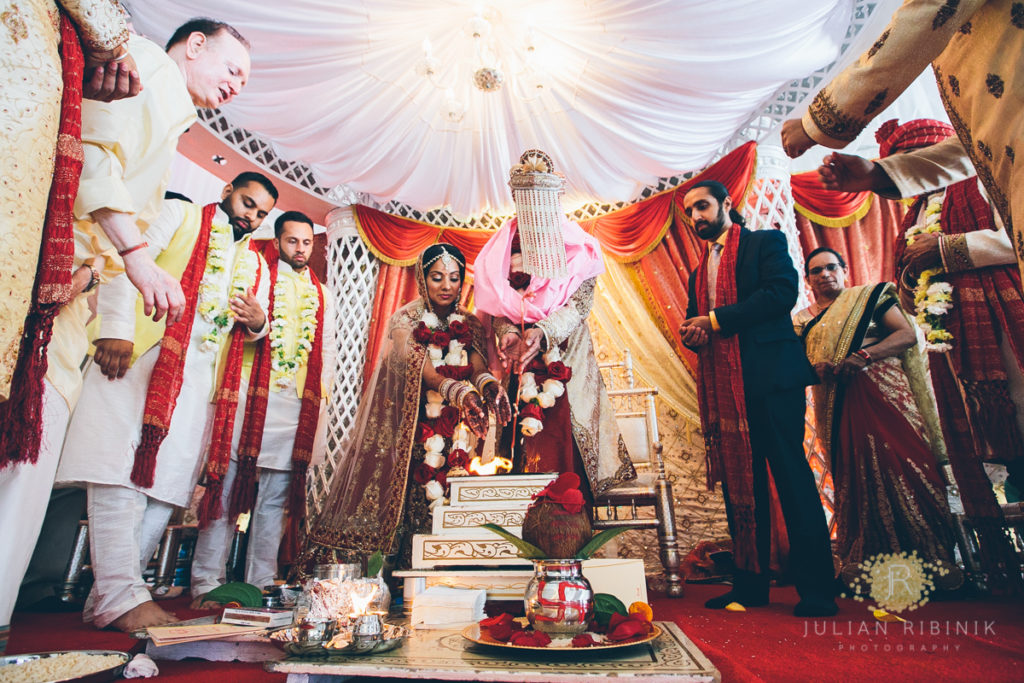
The next ritual is called the Saptapadi, where the couple takes 7 steps together to show their support for each other in a happy marriage. Each step represents a vow that they make to each other. The Pandit then offers blessings for an abundance of happiness, children, food, and prosperity.
Finally, the groom will tie necklaces made of gold, black beads, and sometimes diamonds around the bride’s neck to symbolize their new bond as husband and wife. He will also apply a red powder to the middle of her forehead. To end the ceremony, friends and family will shower the couple with flowers and wish them happiness and prosperity.
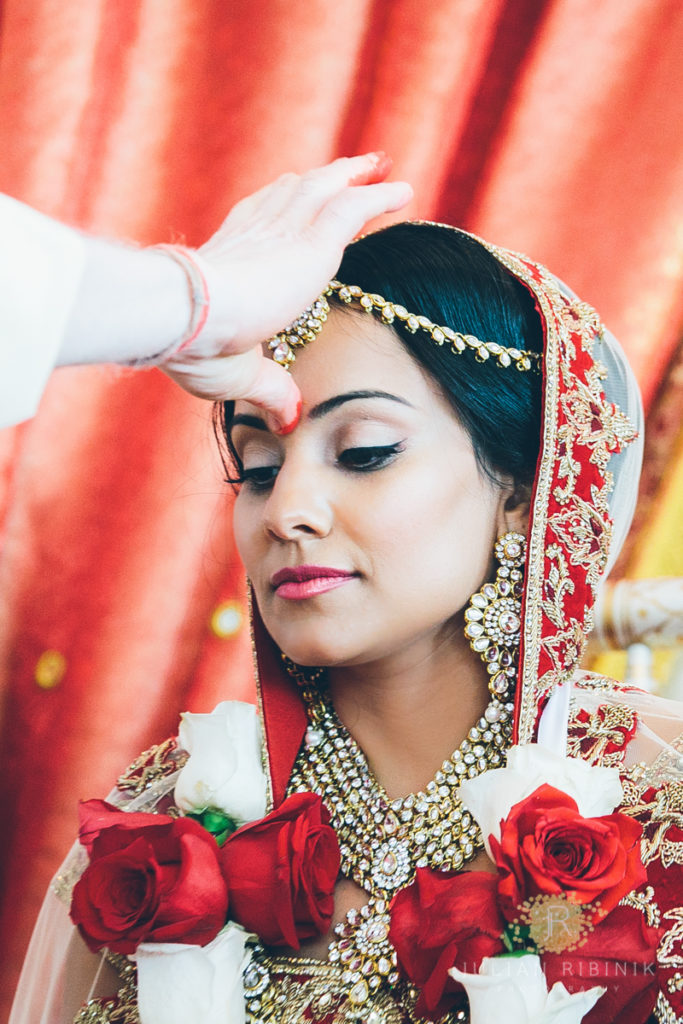
Wedding Attire
The bride’s attire is just as ornate and traditional as the groom’s, with intricate beading, sequins, and delicate fabrics. She usually wears a lehenga (skirt) in shades of red, pink, orange, or gold, which is beautifully embellished with shining mirrors, crystals, and sequins. She’ll complete the look with a traditional red sari representing good luck and happiness. Her sari is sewn with 24-karat gold thread and adorned with jewels. In addition to her ceremonial looks, some brides also choose a boudoir outfit for a more intimate photo session, capturing a softer, personal side of the celebration. She may change her outfit 3 or 4 times throughout the various wedding rituals.
On her head, the bride wears a traditional headpiece called a Maang Tikka. This piece is made of gold, silver, or diamond and hangs down the center of her forehead. It is often adorned with precious gems and stones. The groom usually wears a Kafni during the ceremony, which is a long shirt that extends to his knees.

The Reception Feast
A reception feast is a must for Indian weddings and will often have anywhere from 300 to 500 guests in attendance. Offering a plated menu is challenging due to many dishes being served with a gravy or sauce, so the food is served buffet-style instead. The menu will often feature up to 10 appetizers and 5 main entrees, with sides of rice, naan, and yogurt. The buffet is replenished throughout the night to keep it looking plentiful and ensure that no one goes home hungry.
Like most other wedding styles, the reception will also have professional photographers, videographers, a DJ, florals, favors, and cakes, all on a more extravagant scale. Guests also like to throw money on the dance floor to show support for their happiness and prosperity.
Booking a professional photographer ensures that your Indian wedding traditions are captured with outstanding quality and care.
Indian weddings are rich in tradition, making them a beautiful event to be a part of. The many rituals and ceremonies that take place during an Indian wedding represent the couple’s commitment to each other and their future together. There is no shortage of festivities at an Indian wedding, from the gorgeous attire to the sumptuous feast served at the reception.
At Julian Ribinik Photography, we’ve had the pleasure of shooting many Indian weddings throughout New York City. If you would like your Indian wedding traditions captured by an experienced NYC wedding photographer, view our portfolio and book a consultation today!
